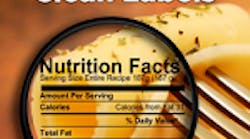E-Book: Make Your Labels Clean, Your Intentions Clear
What began as a trickle has turned into a tidal wave of food & beverage processors replacing questionable ingredients, simplifying their labels and proving their transparency to consumers. Download this Food Processing E-Book to learn about how a careful selection of ingredients can clean up and simplify your ingredient statement. Download the E-Book
Consumers don't have to look too far to find foods with clean labels. People are more interested now about what's in their food, how it's made and where the ingredients come from. They're checking labels more closely, so "natural" and "clean label" are becoming more defined, though the Food and Drug Administration continues to be reticent about creating a definition for them.
No longer are clean label foods only found at small obscure health food stores; they're increasingly impacting major food product developers and ingredient manufacturers, as clean, simple foods are changing America's eating habits.
It’s no surprise that clean labels lead the list of Innova Market Insights' Top 10 Trends for 2015. In fact, clean—or "clear label," as Innova prefers to call it—is far past trend status, says Lu Ann Williams, the firm's director of innovation. “It is the new rule. Companies will have to do what they can to clean up labels or be as transparent as they can going forward,” she says.
From clean to clear
Williams likes the term "clear label," because it ties in the concept of transparency. "The definition about what is clean continues to broaden every year, and clear captures that as well," she says. "Consumers lump it all together—whether it's no artificial colors, no additives, organic or Fair Trade."
Innova sees significant increases in the use of natural ingredients to help product formulators supply clean labels. Consumers demand food with a minimal amount of processing, few if any synthetic chemical preservatives or other ingredients, added sugar or genetically modified organisms (GMOs). Last year's Gallup Study of Clean Food & Beverage Labels also showed that 40 percent of adults were trying to avoid GMOs alone.
Yet while food processors are trying to develop clean label products, they also must ensure the food is safe, so the challenges mount as they explore new processing and preservation methods to satisfy these demands. What about achieving the right texture and consistency? How can they ensure freshness and the proper shelf life? And what about the all-important factor of taste?
How the food tastes could perhaps more easily resolve itself, as a recent consumer study by Ingredion, Westchester, Ill., indicated that consumers perceive natural and clean-label products to actually be healthier and tastier than other foods. Ingredion, which makes clean-label starches with process stability, says that a clean-label product must create trust between consumers and brands.
Recognizing how a clean label can improve product appeal in consumer's minds can be used to develop products with a short, natural list of real ingredients, the study indicates. Gathering industry insight from more than 2,800 consumers across nine European countries, the study showed 70 percent of respondents either always or usually read the front-of-pack claims, while more than two thirds rated the ingredient list as very important. And 61 percent of the respondents said that a "natural/all natural" label claim would make them consider switching brands.
The food industry knows that ingredient choices are more critical than ever in product development. Major processors are dropping artificial ingredients, colorants and flavorings, as well as trans fats and replacing artificial preservatives with natural ones, reducing added sugars, switching to GMO-free ingredients, and reducing or eliminating routine antibiotics given to animals. They're also shifting to more transparent ingredients statements.
But consumers want it all, notes Euromonitor International's contributing analyst, Simone Baroke. "Today’s consumer expects the whole package − a natural product with functional properties that's also low in sugar and/or fat," she recently blogged. "The food industry can't afford to wait for official clarification. It has to react swiftly to changing consumer demands, which have translated into the by now well-established clean label movement."
Manufacturers partnering with ingredients suppliers can balance technological issues with clean foods, explains Jon Peters, president of Beneo Inc., Morris Plains, N.J., which provides a broad range of non-GMO, clean label ingredients derived from chicory root, sugar beet and rice.
"A well-defined selection and combination of the right ingredients is needed to meet or exceed consumers' requirements for taste texture and visual appeal," Peters says. He understands that the development of clean products comes with various technical and nutritional challenges, and his firm and many other ingredient suppliers are ready to help with products that can improve food textures, reduce hardness and brittleness, maximize crispiness and fine-tune or reduce production losses and waste.
The clean label quest isn't a fad. Ingredient panels and their revisions will be a major focus for years to come, Peters and the other industry experts agree.


